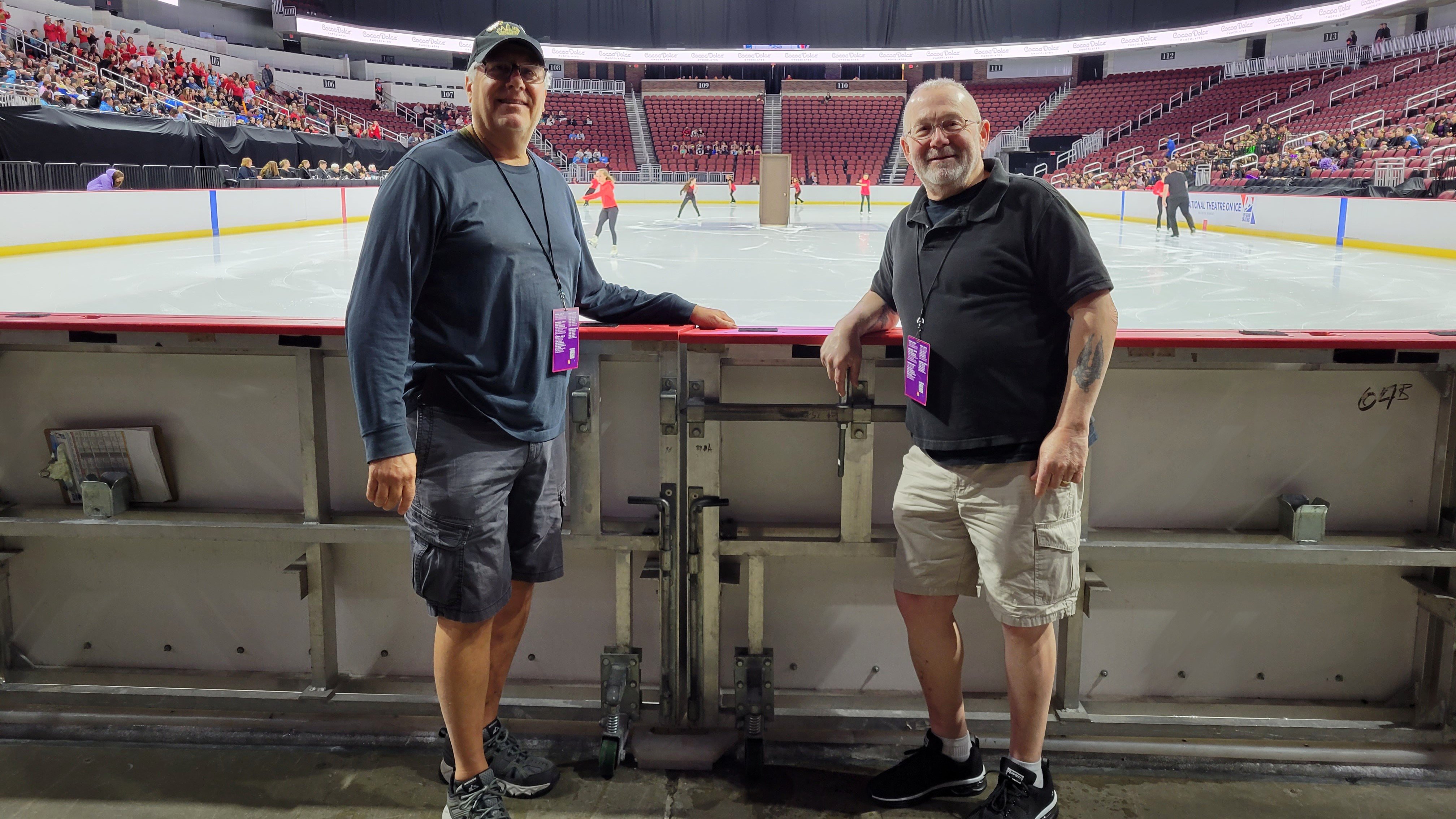Above: Bruce Shropshire and George Woods stand in front of the Zamboni entrance to a TOI event held in Wichita, Kansas, in 2022.
By Mimi McKinnis
A Theatre On Ice free program’s purpose is to express a theme, emotion or story. Each story is told in balanced harmony by a team of up to 28 skaters. Programs can be linear storytelling or abstract, an original work or a reinterpretation of an existing work. Each must reflect the meaning or theme of the story through movement, costuming and the use of props and scenery.
That’s where Bruce Shropshire and George Woods come in. For more than 15 years, they’ve opened the doors for teams to create magic — literally.
“Where it all really started was when someone would need to open the Zamboni doors and start the timer,” Shropshire said. “The kids would have to get everything out on the ice and be all ready to go within two minutes. That was the rule. That’s the very first thing we were involved in — opening the doors.”
“The door had to open when the first skater’s blade hit the ice,” Woods added. “We had to be focused on that to set everything in motion. If any skaters stepped off the ice, or if any prop people stepped on the ice, there was a deduction. We would have to report that, so in a way, we were also acting as judges.”
With each passing year, their responsibilities grew, and the two men began to operate less as volunteers and more as rinkside stagehands, working to keep the National Theatre On Ice competition’s props and scenery operations running smoothly and safely. Originally joined by U.S. Figure Skating TOI official Mike Streeter, when U.S. Figure Skating first sanctioned the event in 2009, a stage crew of sorts was born under the direction of former Theatrical Committee Chair Roland Bessette.
“One year we opened the doors and there was mass confusion,” Woods recalled. “A team had 10 guys with nail guns going crazy on a pile of lumber to make their sets. We didn’t know what to do with it. When I walked over and saw what everybody was doing, I asked how I could help. I asked what I could do. Bruce was already helping. We all just sort of ran into each other that day. We started helping and we never stopped.”
With combined backgrounds in skating, stage management and construction, the two men were no strangers to the challenges TOI presented. Shropshire, a retired United Airlines pilot, had a history of flying city to city to watch his future wife perform with the Ice Capades, often getting a backstage seat to the show’s inner workings. Woods, a drummer and owner of a real estate and construction company, has acted as a road manager for traveling bands, touring with the likes of Black Sabbath and April Wine. Now, what started as a way to occupy their time while accompanying their wives to the arena (Shropshire’s wife coaches Chicagoland Theatre teams and started the program’s first adaptive team, while Wood’s wife skates with Boston’s Imagica adult team), has become a well-oiled machine — and a vital part of every National TOI Competition since its inception.

“I like watching skating a little bit, but not for six or seven days,” Woods said. “My wife goes, so I’m going to be there anyway. I’d rather help. We accepted the challenge, and it’s such a big high-five when we pull it off. It’s very rewarding, helping those kids and helping those people. And now we have a whole big group of friends we get to see. I build houses for a living, but I work harder doing this, trying to figure it all out and get it to happen.”
Of course, the role is not without its challenges. Over the years, both men have watched the discipline explode into a spectacle of figure skating, theater and dance, maxing out when Shropshire’s homebase of Chicago hosted the event and packed an 80’ by 100’ circus tent full of each team’s decorative pieces.
“That’s when people started saying, ‘we need to reel it in.’ It was getting out of control,” he said.
Even with new rules in place that limit each piece’s height to 7’6, and limit each team’s haul to a strict 10’ by 10’ square for storage, each venue presents its own obstacles, and each year brings a different set of teams and themes. It’s nearly impossible to plan ahead.
Some years, just 20 feet separates the holding area and the designated entrance to the ice. One year the two were separated by a freight elevator, and when items didn’t fit inside, the men had to create a system to send props down the fire escape. One year a snapped chain brought about the need for additional volunteers to manually push a 1,000-pound elephant door so props could move in and out. Another had temperatures so high the fire department required an outdoor holding tent be at least 50 feet away from the arena. Whatever the challenge, at the end of the day, both men agree the struggle is worth the effort — and the 16-hour days.
“The thing that we do that’s special, that’s important to us, is that from the beginning, we set a tone for how you behave backstage and how you treat the gear,” Woods said. “We’ve never had a problem. In all these years, we’ve always had teams operate on time. No one in all these years has ever had to get involved from the front desk. I look forward to the camaraderie. It’s the happiest place to be that has nothing to do with skating.”


